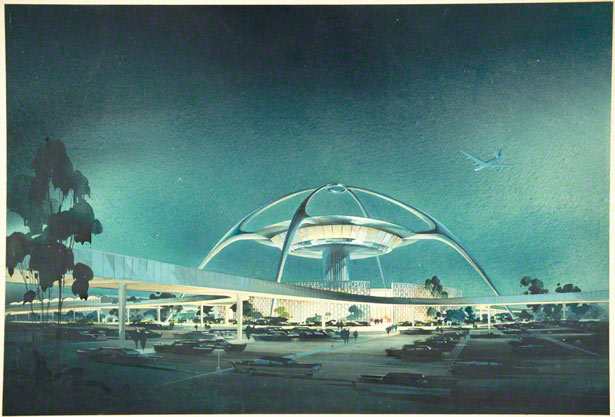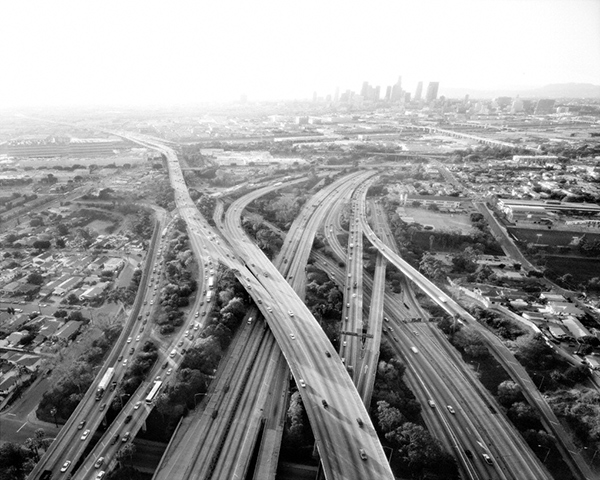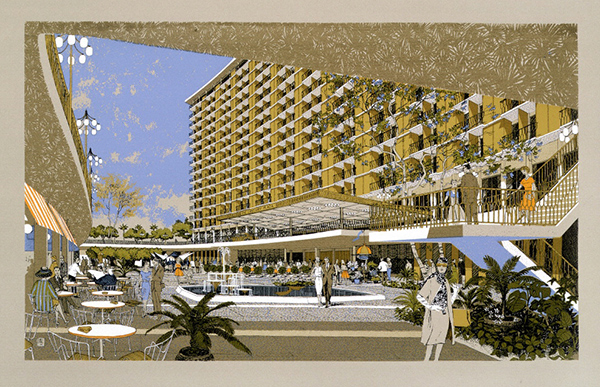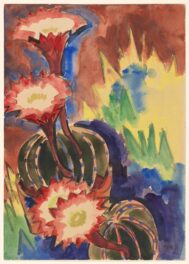
My L.A.: My life mapped on the landscape.
Throughout 2013, the Getty community participated in a rotation-curation experiment using the Getty Iris, Twitter, and Facebook. Each week a new staff member took the helm of our social media to chat with you directly and share a passion for a specific topic—from museum education to Renaissance art to web development. Getty Voices concluded in February 2014.—Ed.
In the three years leading up to the opening of Overdrive: L.A. Constructs the Future, the curatorial team spent a lot of time thinking about Los Angeles. We considered the many well-worn stories and ideas about the city, and what new kind of story we wanted our exhibition to tell. Coming from our various backgrounds, we possessed different investments and concerns. But we had all lived in L.A. long enough that its streets, highways, neighborhoods, and buildings had seamlessly converged with our lives, creating a subjective map that traced not only the city, but our own histories.
One of the most rewarding things about working on an exhibit reflecting the recent history of a city was anticipating that so many visitors would be able to personally connect with the material. For example, maybe you’ll spot a photograph of the downtown skyscraper your sister works in, a model of the binoculars building in Santa Monica you commute by, a church or restaurant you’ve visited, or a drawing of your college. Even if you’re from out of town, there’s a very good chance you’ll be able to connect to LAX or Disneyland, or someplace you’ve seen in a movie.

Vintage L.A.: LAX, Theme Building; perspective view, 1961. Charles Luckman, William Pereira, Welton Becket, and Paul R. Williams. Pencil, watercolor, and gouache on board. From the Alan E. Leib Collection. Image courtesy of and © The Luckman Partnership, Inc. | a Salas O’Brien Company
As a native Angeleno, working on this exhibition made me realize how much of my family’s story is told through L.A.’s evolution. My grandfather had to vacate his apartment because it was being cleared to make way for the 101 Freeway. He met my grandmother when she arrived in L.A. as part of a wave of 1930s European refugees, and they worked in film and aviation. Thanks to the G.I. Bill they bought their first home, in a midcity neighborhood filled with new pastel houses and young families. Years later, my parents moved from a bohemian Venice apartment to an old Koreatown fixer-upper, and taught gymnastics at a Czech cultural hall (now turned Buddhist temple). They paraded in the 1984 Olympics opening ceremony, and joined the booming aerospace industry.

High-speed L.A.: Highways 5, 10, 60 and 101 Looking West, L.A. River and Downtown Beyond, 2004, Michael Light. Archival pigment print, 40 3/8 x 50 3/8 in. Courtesy of Michael Light and Craig Krull Gallery, Santa Monica. Image © Michael Light, Courtesy of Craig Krull Gallery, Santa Monica
The sleek office buildings they commuted to in El Segundo are shown in Overdrive, as is a photograph of my elementary school reflected in the glass of the CNA building. And these are only a few of the intersections I’ve discovered in the exhibit. There are more, and we bet you have your own.

Glam L.A.: Century Plaza Hotel; perspective of exterior sunken plaza, 1962, Minoru Yamasaki and Carlos Diniz. Screenprint, 29 x 43 in. Courtesy of the Diniz family archive and Edward Cella Art and Architecture

High-tech L.A.: IBM Aerospace building; exterior view from ground, about 1967, A. Quincy Jones and Frederick E. Emmons, architects; Eliot Noyes, designer; Amir Farr, photographer. Gelatin silver print, 7 5/8 x 9 9/16 in. Alan Eliot Goldberg
In Overdrive, we’ve gathered a selection of fascinating (if I do say so myself) objects about L.A.’s architecture, and every twist and turn of the exhibit holds stories—for us and for all the people who have helped make Overdrive possible. Did you walk through Overdrive and see part of your story? What are your junctions of place and history? What buildings reflect a bit of who you are?
Connect with more “Our L.A.” content from this week’s Getty Voices:
- We generated a google map of off-beat sites and underrated buildings.
- Chris and Lyra hosted “office hours” on site and collected these responses to the ever-interesting question, “What is YOUR L.A.?” (Taco truck drawings are of course featured)
- Sarah Waldorf harvests some interesting points from the Our L.A. map and shares some sites significant to HER L.A.
- Liz McDermott shares why her favorite site in L.A. is an ice cream chain!
- Ron Hartwig gives homage to St. John’s Cathedral, a site of inspiration for him
- Steve Saldivar shares the hidden past of this East L.A. giant
- A video of Chris and Lyra in conversation about their favorite sites in Los Angeles




Comments on this post are now closed.